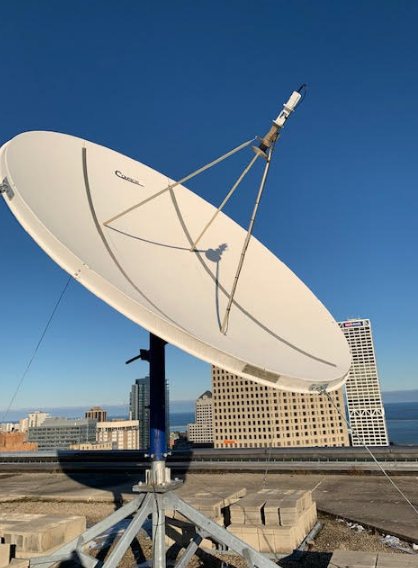When comparing antenna ranges, consider gain, frequency, design, and environmental conditions.
Gain
When it comes to antennas, gain is one of the essential characteristics that has a dramatic impact on its range and function. Gain, quantified in decibels , is a measure of an antenna’s ability relative to an isotropic one to concentrate the power it emits into a specific direction or directions. For example, a standard dipole antenna is usually credited with a gain of about 2.15 dB. In contrast, Yagi antennas that come in arrays of four or more elements can reach gains in the vicinity of 7 dB to 13 dB or even larger.
For home users wanting to improve the effectiveness of their home Wi-Fi networks, the upgrading from a common home router with a gain of about 5 dB to one with a high-gain is severely recommended if they are going to extend their Wi-Fi signal reach.
In commercial applications, such as the use of cellular networks and their base stations, higher gain antennas are mandatory. Such antennas tend to have gains in the range of 15 dB to 20 dB as they allow them to cover far greater distances. They are vital in rural areas where antennas are far apart. With the gain, they have they can send signals over tens of kilometers. Moreover, higher gain equals more effective power use. This way, antennas send more signal power where it is needed the most. Thus, by using a 10 dB antenna rather than a 3 dB one, a broadcasting station might be able to cover double the area that a less efficient one would require without increasing the power output.

Frequency
Frequency is a crucial factor in defining the operational range of antennas, as it directly influences how signals interact with different environments. A frequency determines the wavelength of the radio waves that the antenna emits or receives. In general, lower frequencies corresponding to longer wavelengths allow for longer distances of travel and better penetration through obstacles as opposed to higher frequencies.
Consider the following example in regard to wireless communication. The 5 GHz band, which is considered to be of higher frequency, provides faster data rates and less time to transfer due to shorter wavelength. However, in comparison with 2.4 GHz, which is a lower frequency band, it is limited in terms of coverage and ability to move through obstacles. Still, due to a lower wavelength, a 2.4 GHz band is less efficient in data transfer and susceptible to more types of interference, while a 5 GHz is less likely to be used by such regular household devices as a wireless phone or microwave and thus may be more effective in a smaller open space for high-bandwidth applications, such as video streaming or gaming.
For overall broader areas, longer distance of travel without considerable power input, and better penetration, such frequencies as 700 MHz or 900 MHz are used in remote communications. Lower frequencies have larger wavelengths, which allows them to move across large areas without substantial effort. Moreover, they still provide more than enough speed for such purposes as rural internet services or emergency services. The sole downside of their range is that in metropolitan areas with high concentration and limited radius, these frequency ranges are not effective. Similarly, there is a reverse situation with such frequencies as 24 GHz or 60 GHz, which are used in point-to-point communication systems and have a limited range and ability to penetrate obstacles. While they support extremely high data rate, they are limited to clear installation and line-of-sight configurations.
Antenna Type and Design
The type, as well as the design of an antenna, is one of the primary factors that determine its range and relevance to a specific application. Depending on its purpose, different antennas have been designed, affecting such characteristics as directionality, bandwidth, and in general the efficiency of signal transmitting and receiving. One typical example is the contrast between omnidirectional and the so-called directional or beam antennas. The former allows a signal to be radiated in 360 degrees and received from all of these, hence they can simultaneously connected to multiple devices. This type is commonly used in the development of mobile devices as well as in wireless routers. These are more convenient for such applications, however, their range is shorter, and they are easily prone to any kinds of noises arising from any direction.
Directional antennas, however, such as Yagi, parabolic, and panel antennas, focused its energy in a particular direction and, as a result, have significantly increased range and much less susceptible to noise that might emerging from unwanted directions. Yagi is constituted by several parallel elements incorporated in a line and functions very well in the context of a few kilometers point-to-point communication. Its design is optimal for such applications desired for remote control systems, long-range Wi-Fi networks, or television reception in rural areas. Parabolic, on the contrary, is characterized by very high gain of a curved parabolic reflector, and it manages to focus the propagating signal into a narrow beam. Therefore, it can be effectively applied to long-distance communication links, satellite communication, or radar systems. The latter can be concentrated into a few-degree form that allows for undisturbed communication even for thousands of kilometers. For example, if one has a standard antenna Wi-Fi router with a gain of 5 dB, replacing it with a 12 dB directional panel may prove advantageous, taking into account that such network could be extended many times the usual reach.
Environmental Conditions
Environmental conditions have a significant impact on the range and appropriateness of antennas affecting signal propagation and location-based antenna selection. The main environmental conditions are physical obstructions, atmospheric conditions, and electromagnetic noises. The physical obstructions, including buildings, trees, and mountains, can block or reflect the radio waves. Built-up areas with high concentrations of buildings and concrete are more likely to induce a complex and unpredictable propagation environment. Radio waves can be reflected, transmitted, or destructed by the surrounding structures, which causes multiple paths to be scattered between the transmitter and the receiver. This multipath interference causes the signal to arrive over undesired paths, lowering the range and clarity of communication. In contrast, rural areas have fewer multipath effects; hence signals may not reach far due to distances between homes and the choice of obstacles such as valleys. For example, the optimal range of an antenna placed at the bottom of the valley surrounded by high hills and mountains is dependent on the required signal reach and the height of the surrounding mountains.
Atmospheric conditions such as rain, fog, and humidity can significantly attenuate the signal, especially at high frequencies. Rain can reach the critical value of 0.01 dB per kilometer and begins soaking about 10 GHz frequency range used in satellites and some broadband communications. The signal attenuation leads to fading of the signal strength and signal quality for some times.
Rain can last for several hours, and the quality can degrade for extended periods. For example, rain fade causes satellite TV signals to fade out, making it difficult to watch.
Electromagnetic interference from other antennas, power lines, or other devices can prevent signals from being transmitted. For example, industries are prone to heavy interference, hence electric devices will more frequently jam; in such cases, directional antennas that are highly screened are essential.
In summary, selection of appropriate antennas and equivalent equipment is critical in overcoming environmental conditions. It could mean the use of omnidirectional antennas to overcome physical obstructions or highly directional antennas in rural areas. Knowledge of atmospheric effects and noise is also critical in acquiring appropriate equipment with minimal attenuation and interference. Maintenance of good communication is important in ensuring a cheap and effective network.






